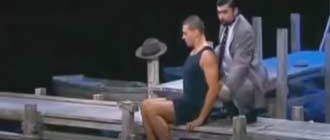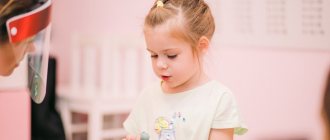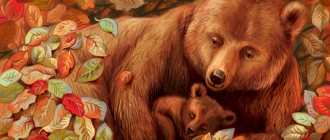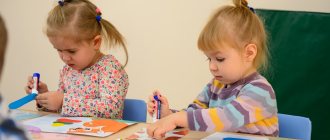Preview:
Municipal budget preschool institution
kindergarten No. 2 Neverkino
Lesson summary on the topic:
“Where there is water, there is life”
(acquaintance with the surrounding world
children of senior preschool age).
- Introduce children to the properties of water (taste, color, fluidity).
- Develop children's curiosity, thinking and speech; introduce the following words into the children's active dictionary: liquid, colorless, tasteless, transparent.
- Give an idea of the importance of water in human life and in nature.
- Foster respect for water.
Equipment: audio recording of surf noise; photographs of desert and forest; water in glasses; teaspoons; salt, sugar, milk; flannelograph, planar model of a river, streams, a person.
Children enter the hall and sit on chairs.
Educator: Children, look what I have in my hands?
Educator: Correct. What do you think the globe is a model of?
Educator: That’s right, this is a model of our planet earth. Tell me what color is the water? And what kind of land? What is more: sushi or water?
Educator: That's right - water.
Educator: Today we are going on a trip. And, since we have to sail along the river, let's choose some type of water transport. What types of water transport do you know? What will we choose? (children's answers: steamship, boat, yacht, cutter, catamaran, etc.) Close your eyes and listen to the water splashing overboard. A journey with several stops awaits us, and here is the first pier. We will stop and remember what we know about water.
1. Marina “Where there is water, there is life”
- What do we use water for every day?
- Why do you need to water indoor plants?
- How many days do you think a person can live without water?
Every living thing, including plants and animals, needs water. Without her, everything dies. For example, a person can live without water for only a few days (from three to seven). Take a look at these two pictures. This is what a desert looks like without water, but this is what the banks of a river or lake look like. (Show pictures.) Well, let's go further, another stop awaits us around the next bend in the river.
2. Pier “Where did the water come to us from?”
Listen to the droplet's story.
Educator: Once upon a time there was a small stream. He ran among forests and meadows. On the way, he met a stranger who was very similar to him.
“Who are you?” he asks.
- I am a trickle. And who are you?
“And I am a stream,” our stream answers. “Let’s be friends and flow on together.” Thus, the waters of many streams merged into one large and beautiful river. It rolls its waters for many kilometers, generously giving water to people along the way. A Man came to the river, admired its clear waters and asked the river to share its gifts. Man installed pumps to pump water from the river and supply it to the water supply system. But no matter how clean the water seemed to Man, grains of sand, particles of silt, and dirt still remained in it. In order to get rid of these “fellow travelers” of water, Man had to build treatment facilities and only after purification send the water on its further journey – to our water taps. This is how I, Droplet, came to you.
A droplet makes such a long and difficult journey, and it becomes precious because it costs a person dearly.
(during the teacher’s words, a river modeling is carried out).
Educator: How is a river born, do you want to know?
(places a wide and long strip of blue paper in front of the children).
The teacher conducts an experiment in water purification (experimental activity).
Educator: Let's try to clean the dirty water together. To do this, take a funnel, put a special filter cloth (made of cotton wool and gauze) into it and start passing dirty water through this funnel. Let's see what we can do?
We will conduct an experiment
We'll find clean water.
We will not allow dirt to pass through the filter,
So they can drink water!
Conclusion: after purification, the water became clean, but it is still not drinkable. It must be boiled and only then will it be suitable for drinking.
Educator: Yes, we cannot live without clean water. We only need clean water! Who else needs fresh water while reading?
Pier "Dance with Cloud"
Educator: A cloud has appeared on the horizon, let's look through our binoculars (children use their hands to make binoculars). Do you see the cloud?
Educator: What does a cloud consist of?
-From droplets of water.
Educator: Do you want to turn into droplets? One, two, three little bits of life.
A dance game is held with children.
Educator: Well, a cloud passed, gave everyone water to drink, nature came to life, and you and I continue our journey.
We stopped and now let’s get to know the water better and do several experiments with it.
Experience No. 1. "Water is a liquid"
Educator: Water is a liquid. It can be poured into anything: a glass, a bucket, a vase. It can be poured, poured from one vessel to another.
Experiment No. 2 “Colorless water”
On the teacher’s table there is a glass of water, a glass of milk, and a spoon.
Teacher: (dips spoon into milk) Guys, can you see the spoon? ( No ) . (puts the spoon in the water) Can you see the spoon now? (Yes).
Educator: What color is the milk? (white) What color is the water? (water has no color, water is colorless).
Experiment No. 3 “Water without taste”
Educator: And now I suggest you guys taste the water. What is she like? Sweet? Salty? Sour? Bitter?
Educator: Water has no taste, it is tasteless. Let's do a little experiment. Let's put the substance that is on our table in a glass of water. Stir and now taste the water. What did it taste like? (children's answers). What do you think I added to the water? (children's answers). It turns out that water can take on the taste of the substance that is put in it.
Today you learned a lot about water. Let's recap what you learned:
Water is a liquid.
Educator: Guys, do you need to save water? Why? (children's answers)
Lesson conclusion: For washing and cooking, only purified water is needed. And to get clean water, people spend a lot of work and effort. This is why you need to conserve water and close the tap tightly.
Source
Abstract of GCD on the surrounding world “Water Sorceress” in the senior group
ALIYEVA ASIYAT
Summary of educational activities on the surrounding world “Water Sorceress” in the senior group
Abstract of the GCD on the surrounding world “ Water Sorceress ” in the senior group .
Program content: introduce children to the properties of water (taste, color, smell, fluidity)
.
Draw children's attention to the importance of water in our lives. To consolidate children's knowledge about where and in what form water exists in the environment .
Develop curiosity, thinking, memory, attentiveness. Vocabulary work: introduce into the children's active vocabulary: liquid, colorless, tasteless, transparent. Get used to answering with a complete answer.
Materials and equipment: Equipment for experiments: glasses of water (according to the number of children, empty glasses, salt, sugar, potassium permanganate, spoons, a basin, vessels of various shapes, a white sheet of paper, cups of milk, napkins, symbols indicating the properties of water.
Summary of GCD Introducing children to the word
GCD outline plan
on teaching literacy for the senior group
Subject. Introducing children to the word.
Goal: to form children’s ideas about the word as an intonation and semantic unit of speech. Program objectives: 1. Familiarize the child with the word. 2. Acquiring the ability to listen attentively to the spoken word. 3. Learn to ask and distinguish the questions “Who is this?”, “What is this?” 4. Fix in children’s speech a word denoting a “living” or “non-living” object. 5. Continue to educate children to speak every word distinctly, clearly, intelligibly. Materials and equipment: player for audio recordings; a beautifully designed box with riddle pictures in it; doll; teddy bear; photograph of a bear; a set of pictures “Fun exercise”, depicting a human figure in motion; the summary uses the didactic game “Add a word” by the author I. Tokmakova; warm-up by E. and S. Zheleznov “We are stomping, stomping, stomping.”
GCD move:
Part I.
- Guys, there are many different objects around us, and we can say something about each object. Now I will show you pictures and ask “What is this?”, and you answer me in one word (pointing to various inanimate objects). Children answer, for example, book, table, ball, etc. - How can you ask about these items? What is this? - And now I’ll ask you differently: “Who is this?” (I show pictures, point to animate objects: a bird, a fish, a cat, I point with my hand at the nanny, at the children, at myself). How can you ask? Who is this? - Now I will name you different objects, and you ask me the question “who?”, “what?” (Thus, I gradually introduce children to the concepts of “living” and “non-living”). — I invite a girl at will, put a doll next to her and ask the children a question. — What is the difference between a girl and a doll? (children name the differences and together come to the conclusion that the girl is alive, and the doll is inanimate, a toy). Then I show an illustration with a bear and a toy bear depicted on it. - Guys, are they any different from each other? We find out that the bear toy is not alive, but the picture depicts a living bear. To summarize: - All words denoting inanimate objects answer the question “what?”, and words denoting living objects answer the question “who?”
Part II.
Physical pause “Fun exercise”, the cards show schematic images of little people in different poses. Children need to repeat the same movements.
Part III.
- Guys, look at what an unusual box I have, it’s not simple and very mysterious, because there are a lot of mysteries for you that are waiting, can’t wait to be helped, finally solved. - Interesting? Then listen carefully to the end of each riddle and answer the questions “who is this?”, “what is this?”. Is this object living or inanimate? •What always goes, but never leaves its place? (hours) •Winter and summer the same color? (spruce) •Do I wake everyone up on time, even though I don’t wind the clock? (cockerel) •Do the red paws pinch the paws? (goose) •She lives in water, has no beak, but does she peck? (fish) •Without a tongue, but speaks, without ears, but will he hear? (phone) Next, I invite the children to come up with or remember a riddle on their own and ask all the children. Children make riddles and guess. This object is called living or inanimate.
Part IV.
Physical pause “We stomp stomp stomp with our feet”, children perform exercises to the music: We stomp stomp stomp with our feet, We clap clap clap with our hands, And we can turn here and there without difficulty. We will nod our heads, wave our arms together, and turn here and there without difficulty. We will jump high, Jump together so easily, And we will turn here and there without difficulty.
Part V
- Now, I will say the word, and you tell me what it means, how you understand it. Listen, book! What does this word mean? (Children's answers). - That's right, you understand well what the word book means, what meaning it has. - Now, I will pronounce different sound combinations. Listen: na, mu, rum, po, ba, etc. Tell me, is it clear what they mean, what meaning they have? (Children's answers). “These are not words, these are just sound combinations, syllables that by themselves, separately from each other, mean nothing, have no meaning.” And when the syllables together they make up words, and each word has a meaning, a meaning. - Let's play the game “Add a word.” A spoon is a spoon, soup is eaten with a spoon...(eat) A cat is a cat, a cat has seven...(kittens). A rag is a rag, I’ll wipe it with a rag... (table). A hat is a hat, I got dressed and went... And I came up with a word, a funny word - plim. And I repeat again - plim, plim, plim. Doesn't jump, doesn't jump plim, plim, plim, And plim, plim, plim doesn't mean anything. — What is “plym”? That's right, this word doesn't mean anything. (Children are asked to say the word “plim” with different intonations). -Now, let's play the game “Name the Word” (goal: learn to distinguish between words denoting an object and words denoting actions). In front of the children, I lay out object pictures on the table depicting a table, a butterfly, a cube, a sitting person, a running child, etc. -Children, look at the pictures and name one word to which you can ask questions: who is this? What is this? What is he doing? (for each correct answer the child receives a picture).
Part VI.
Final. - Thank you, I liked the way we played today. Today we learned so many new things (here you can ask several children what new they learned). Summarize. - Today we learned that all words denoting inanimate objects answer the question “what?”, and living objects answer the question “who?”, we also know that words consist of syllables, and each word has a meaning.
Lesson summary on the surrounding world for grade 2 on the topic “Structure of the human body”
Notes on the world around us, grade 2.
Lesson topic: “Structure of the human body”
Goals and objectives of the lesson:
1. Give initial information about the work of human internal organs.
2. Develop students’ cognitive activity.
3. Understand the difference between the concepts of “external” and “internal” structure of the human body.
4. Develop observation, attention, memory.
5. Teach children to work with scientific text and the ability to highlight the main thing in it.
6. Cultivate a caring attitude towards your health.
7. Form relationships of cooperation, mutual assistance, and adequate self-esteem.
Equipment and materials:
presentation; test for students; for experiments: foam sponge, liter jar of water, balloon, rope, hourglass.
During the classes.
1.
Motivation of students.
— Today our lesson will be devoted to a very important topic. Why this topic is very important, you will try to answer yourself at the end of the lesson. And now our lesson can be called this: “About myself” (1 slide)
— This is the name of the book by the writer Alexei Dorokhov (demonstration of the book). Has anyone read it? I advise you to definitely read this book.
2. Actualization of mental activity, inclusion of attention and imagination.
- Now we will play the game “Find out and name.” (2 slide)
I will show silhouettes of various animals, and you tell me who it is? (3 slide)
3.
Problem-based – dialogical conversation.
— How did you manage to recognize this or that animal, by what signs did you recognize a person? (according to the external structure of the body)
- Now I suggest you look at one more picture. (4 slide)
-What do you see? (house)
— How is the house arranged from the outside? (Roof, door, windows, etc.)
— What we see from the outside is the external structure of the house.
- How can you figure out what is inside the house? (furniture, appliances, dishes, etc.)
— What we can see inside is the internal structure of the house.
Conclusion:
The structure can be external and internal. (
table on the board)
structure
external internal
4.
Communicate the objectives of the lesson.
— Today in class we will talk about the external and internal structure of the human body
.
5. Primary introduction of material, taking into account the laws of the cognition process.
Work in pairs using the textbook p. 6-7
— What is shown on p. 6? (external building)
— What is shown on p. 7? (internal structure)
6. External structure of a person.
- Look at each other and tell us how the human body works from the outside. (children's statements)
— So, the external structure of a person includes the following parts of the body: (5 slide)
- What is another name for arms and legs? (upper limbs)
— How to call the chest, stomach and back in one word?
7. Internal structure of the body.
— We looked at the external structure of the human body. What is its internal structure? Tell us what you know about it. (children's statements) (6 slide)
— The human body inside consists of organs. Our textbook pp. 8-9 can tell us more about them.
1.Brain
(children read the textbook material out loud) (slide 7)
(teacher's story)
— Indeed, the brain controls the functioning of the entire organism. You look around and see objects, people. You read, you write. You can easily remember where you were yesterday and imagine the zoo you visited last summer. You solve examples or a problem. All this happens as if by itself. But that's not true. Your thoughts, movements, and feelings are controlled by the brain, the most important organ of the body. The brain is the main command center of the body. Whatever a person does, everything is controlled by the brain.
- In what part of the body is this organ located? (in my head) (8 slide)
2. Lungs.
- The brain controls all human thoughts and feelings. In charge of the proper functioning of the main internal organs. He is the one who monitors how we breathe.
- How long can you go without breathing? Let's check. On my signal, you will hold your breath. When you feel like inhaling, you raise your hand.
- So, draw a conclusion for how long a person can go without breathing.
— A person needs to inhale and exhale air all the time. Breathing occurs with the help of the lungs. (9 slide)
(children read the textbook material out loud)
(teacher conducts experiments)
- Each of us has two lungs - right and left. The lungs are like two sponges. When we exhale, they release air and decrease in size; when we inhale, the lungs fill with air and expand.
— Half a ton is 500 kg or 500 of these cans. (show a liter jar of water)
- In what part of the body are the lungs located? (in the chest) (return to slide
3.Heart.
- Tell me, how do they find out whether a person is alive or dead?
- First of all, they listen to whether his heart is beating. (10 slide)
Where is it located? (in the chest on the left side)
(return to slide
- Place your palm on your heart.
(children read textbook material)
4. Stomach.
- Imagine that you came home. It's time for lunch, and mom gives you a piece of raw meat and two raw potatoes on a plate. Will you eat such a dinner?
“In the same way, our body needs specially processed food. Everything that gets into your mouth: cutlet, porridge, bread, and candy must be digested and absorbed into the blood. This is what the “internal kitchen” organs do.
— The main compartment of the “inner kitchen” is the stomach. (11 slide)
(experience) The stomach resembles a bag. Without food he is like a deflated balloon. If you blow into the balloon, it will inflate a little. It’s the same with the stomach: when food gets into it, it stretches. The more food we eat, the more our stomach stretches. But it cannot fit more than 2-3 liters of food.
-Where is the stomach? (in the upper abdomen, under the ribs) (return to slide
— Why do you need to chew your food well and not swallow in large pieces?
(children read textbook material)
5.Intestines.
- But where does the stomach push semi-digested food further?
(children read textbook material) (12 slide)
(experience) The intestines stretch for almost 8 meters. (show. rope 8 meters long)
-Where is the intestine located? (return to slide
6. Liver.
- this could end the conversation about the “Inner Kitchen” of the body. However, we have not yet mentioned the extraordinary neighbor of the stomach - the liver. (13 slide)
(children read textbook material)
— The liver lives on the right side of the stomach in the upper abdomen. (return to slide
It produces bile, which enters the intestines and helps digest food.
8. Physical exercise.
(14 slide)
9. Generalization and systematization of acquired knowledge.
1) 6-7 students work on the test.
2) 2 students work at the board. (Locate the internal organs on the model of a person and connect them with the name with arrows)
3) the rest of the children complete the task in the workbook page 3 No. 1.
10. Testing and evaluation.
1) checks the computer.
2) collective review under the guidance of a teacher.
3) mutual verification using a presentation. (15 slide)
- Evaluate your knowledge yourself. Color-code the rating. (16 slide)
11. Lesson summary.
— Guys, we have studied a new topic. Can you now say why this topic is very important? (You need to know well how your body works and how its organs work in order to live and be healthy!)
- We will talk about how to properly monitor your health in the next lesson.
12.Homework.
— Solve the crossword puzzle in the workbook p. 3 No. 2.
— Create your own daily routine.
13. Completion of the lesson . (17 slide)



